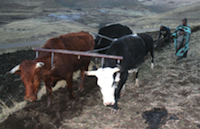Thursday, April 18, 2024
News and Views from the Global South
Lesotho Could Beat Drought With Irrigation
Khutliso Sekoati
- Bonang Charles’s fields are a richly green rarity in October’s parched landscapes along the Phutiatsana River. It’s a vivid demonstration of the limited reach of irrigation to Lesotho’s small-holder farmers.

Climate change is expected to increase the frequency of drought, with devastating effects on farmers who depend on rain for their crops. Credit: Tomas de Mul/IRIN
Other farmers in the area have since abandoned farming entirely for lack of rain; but Charles is prospering from his harvests of spinach, rape and peas.
Lucky break
The key to his success is a pump he bought secondhand from the ministry of agriculture, one of four unwanted pieces of equipment the ministry was disposing of.
Charles paid $7,400 in instalments for the petrol-fuelled pump which he has set up beside the perennial Phuthiatsana to water his fields.
“I have not looked back since I started this venture eight years ago. I am able to feed my family and supply other customers in other districts,” says Charles, watching his six employees spread fertiliser on one of the fields. The produce is mostly sold wholesale to people who in turn sell it in street markets in Maseru and beyond.
“I have lived off agriculture all these years,” Charles says. “I assure you there is life in agriculture and land use and I will never starve when I am in food production.”
The highlands cropping season starts in August, and the Charles operation is buzzing with activity; yet his neighbours’ fields lie barren. Without rain, they cannot plough and plant. The situation has worrying echoes of the 2006-2007 growing season, which was so blighted by drought that the country declared a food crisis in 2007.
Reducing farmers’ dependence on rain to water their crops is essential to build resilience to drought, not only in Lesotho but across the Southern Africa region. It is predicted that droughts will become more common in the future in this part of the continent due to climate change.
Charles was fortunate enough to be able to raise the money to seize a one-off opportunity to purchase the pump at the heart of his success, but the government has made efforts to extend irrigation to people with more limited means, with mixed results.
Finance is a problem
Further along the river, Thoso Bokaako is a frustrated man. An irrigation officer from the ministry of agriculture, he is surveying dry, unplanted fields meant to be supplied with water by a dam constructed by his department.
“Farmers fear to plough their fields as they have to be irrigated with a pump,” he explains. “But it is costly to maintain in case it breaks down. So it is lying idle.”
The government’s programme of support for farmers includes recovering all or part of the costs of assistance. The agriculture department hires out equipment to farmers, for example: having a hectare of land ploughed with a ministry agriculture costs the equivalent of $70.
But requiring farmers to carry maintenance costs for irrigation pumps seems to have exposed the level of poverty in rural areas rather than reduce net costs to the government.
The farmers in Bokaako’s district have been unable to take over the maintenance costs of the pump. He says the ministry is now working on the introduction of gravity-fed irrigation systems, taking advantage of the Lesotho highlands’ steep hillsides to deliver water to the fields.
One such system is already operational in the area of Roma, 15 kilometres away from the Phuthiatsana, enabling 22 communal farmers to grow crops all year round.
It consists of weir dams – low barriers that raise the level of the water in the river without reducing its flow – storage tanks and pipes running down to the irrigated fields at lower elevation. Similar systems are being installed in the Matsieng and Mazenod districts that Bokaako is responsible for.
“The system will be operational soon, as it was completed in September. It is now being tested,” he says.
Around 800,000 rand has been invested in these gravity-fed irrigation projects.
“The three schemes have been initiated by the ministry to overcome the impacts of drought. Most of our subsistence farmers rely on rainfall for cropping,” says Bokaako.
Surveying the Thaba-Bosiu area, Thai Thai, a mechanical engineer at the district agricultural office, says the weather pattern in 2010 is familiar and calls for more action to protect small-scale farmers.
“There was lots of rain in the beginning of 2002, but it stopped when it was time for cropping. There is need to build dams,” says Thai, who has 28 years of experience in agriculture.
He would also like to see the government take over the operation of existing irrigation schemes as part of support offered to farmers.
“The irrigation pipes have been laid in the fields but no ploughing is going on. I think the government should assist the farmers,” he says.

 Print
Print



